Wind and gravity design for tall walls in wood buildings
by Katie Daniel | July 6, 2017 12:03 pm
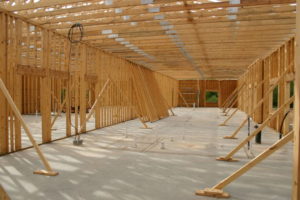 [1]
[1]All photos courtesy American Wood Council
by John “Buddy” Showalter, PE, Bradford Douglas, PE, and David K. Low, PE
Many regions of the United States are at risk of high wind threats such as hurricanes, downbursts, and thunderstorms. All buildings, regardless of materials used, face risk of damage during high-wind events. The concept of resilience—the ability to withstand and recover from such events—is not new. For the built environment, techniques to improve resilience have evolved over time and continue to play an increasingly important role in creating safe, sustainable structures in which people can live and work.
When designed and constructed in accordance with modern building codes and standards, wood construction has a history of proven performance in meeting the challenges of high wind loads. One of wood’s key characteristics is it can carry substantially greater maximum loads for short durations, as is the case during high winds. For any project, a thorough understanding of the interaction between wind loads and material properties is key to the design process. A load duration factor of 1.6 is typically assumed for wind design. (Wood has several unique design characteristics, one of which is duration of load. This is the material’s ability to resist higher stresses when loads are applied for a short duration of time. In other words, wood has a higher strength when a load is applied instantaneously than it does when the load is applied for a long period. This relationship between time, strength, and load magnitude was observed as early the mid-sixteenth century. The factors used in the National Design Specification for Wood Construction [NDS] today were developed in 1948 after research conducted during World War II.)
As with seismic performance, the fact wood buildings often have repetitive framing members attached with numerous fasteners and connectors also helps resist forces associated with high wind. Wood studs designed to resist wind loads in either loadbearing or non-loadbearing tall wall applications are good examples of resilient design. Tall walls can be defined as those exceeding the International Residential Code (IRC) prescriptive limits of 3.1 m (10 ft) for loadbearing walls.
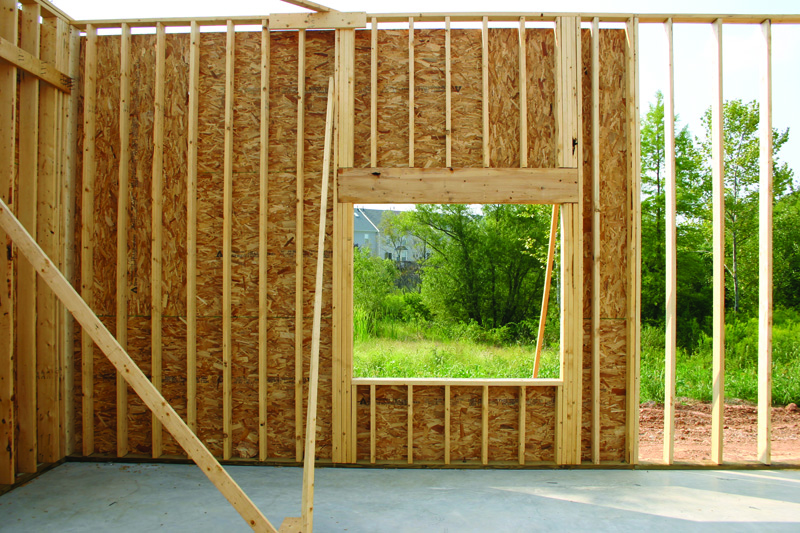 [2]
[2]Proper design of wood structures to resist such wind loads also requires correct use of wind load provisions. Minimum design loads must be in accordance with the governing building code or, where applicable, other recognized minimum design load standards such as American Society of Civil Engineers (ASCE) 7, Minimum Design Loads for Buildings and Other Structures. Wind load provisions have been developed for design of major structural elements using ‘main wind-force resisting system’ (MWFRS) loads and secondary cladding elements using ‘component and cladding’ (C&C) loads. Elements and subassemblies receiving loads both directly and as part of the MWFRS—such as wall studs—must be checked for both the MWFRS loads and C&C loads independently.
Studs should be designed using MWFRS pressures when considering the combined interactions of axial and bending stresses, and designed using C&C pressures when considering axial or bending stresses individually. This interpretation was developed because only MWFRS pressures provide loads that have been temporally and spatially averaged for different surfaces (MWFRS loads are considered to be time-dependent). Since C&C loads attempt to address a ‘worst case’ loading on a particular element during the wind event, these loads are not intended for use when considering the interaction of loads from multiple surfaces (C&C loads are not considered to be time-dependent).
This is not uncommon; in most cases, it can be considered the controlling limit in wind design of loadbearing and non-loadbearing exterior studs. However, until sufficient boundary conditions are placed on this simplification, both MWFRS and C&C load cases should be considered.
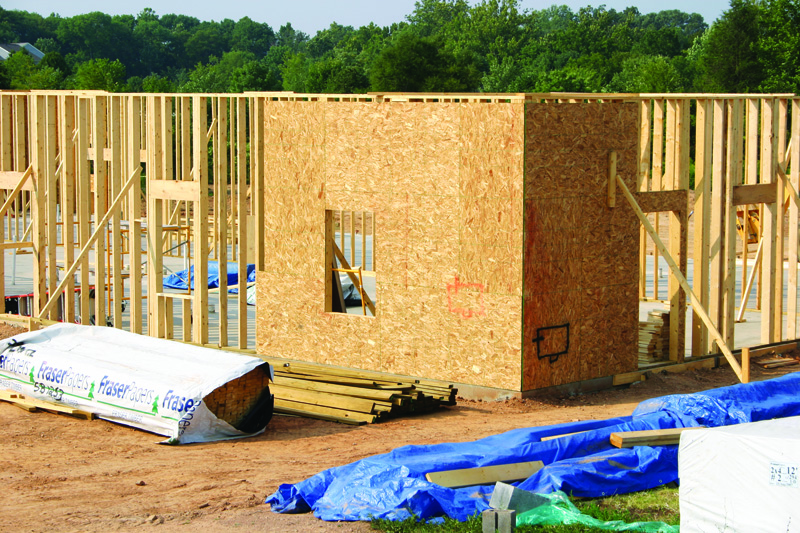 [3]
[3]AWC resources
To aid building designers and construction professionals in addressing the challenges associated with high wind, the American Wood Council (AWC) has developed several code-referenced design standards for wood construction for a variety of building types. (For more information on these resources, visit awc.org/codes-standards/publications[4]. Also, see Showalter’s four-part series of web articles on The Construction Specifier site, beginning with “What the 2015 International Building Code means for wood construction[5].”)
NDS
The 2015 National Design Specification for Wood Construction (NDS) includes necessary design procedures and design value adjustment factors for:
- solid-sawn lumber;
- structural glued-laminated timber (glulam);
- timber poles and piles;
- prefabricated wood I-joists;
- structural composite lumber (SCL);
- wood structural panels;
- cross-laminated timber (CLT); and
- connections to resist lateral and gravity loads.
Per the 2015 NDS, all members must be framed, anchored, tied, and braced to meet required strength and rigidity. The design values for wood studs and the beam and column buckling formulas used to design studs for axial and lateral loads are incorporated in the NDS.
SDPWS
The 2015 Special Design Provisions for Wind and Seismic (SDPWS) provides specific design procedures for wood members, fasteners, and assemblies to resist wind and seismic forces. In addition to shear wall and diaphragm design, SDPWS offers design criteria for members and connections subject to out-of-plane wind loads. One very specific provision pertinent to tall wall design is the wall stud bending strength and stiffness design value increase, where reference bending and bending stiffness values are permitted to be increased based on the presence of exterior wood structural panel sheathing and interior gypsum wallboard with specific attachment requirements.
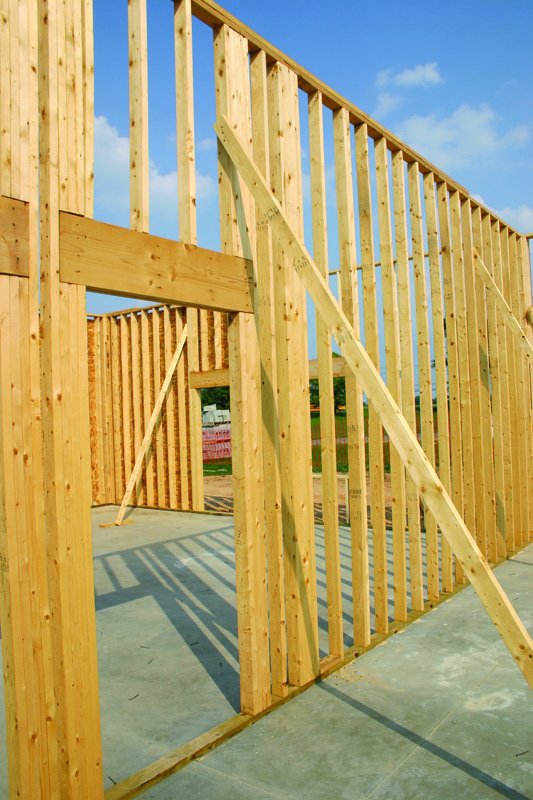 [6]
[6]WFCM
The 2015 Wood Frame Construction Manual (WFCM) is another AWC standard integral to wood design, providing engineered and prescriptive design requirements for one- and two-family dwellings. However, it also serves as a useful tool in the design of nonresidential buildings in Risk Category I or II that fit within the WFCM scope of building size and assigned loads. Examples include projects where the bottom floor is used for stores, offices, and restaurants.
For buildings within its scope, WFCM contains both engineered and prescriptive solutions for wind, seismic, and gravity loads. The engineered provisions in WFCM Chapter 2 offer, for example, tabulated wind loads and gravity loads based on assumptions from ASCE 7 provisions.
Prescriptive wood solutions in Chapter 3 tabulate both loadbearing and non-loadbearing stud lengths for common lumber species resisting wind loads for various deflection limits and sheathing types. For the prescriptive solutions in WFCM Chapter 3, loadbearing walls are limited to a maximum of 3 m (10 ft), while non-loadbearing walls can be 6 m (20 ft) tall.
In Chapter 2, WFCM permits loadbearing studs up to 6 m (20 ft) tall. For C&C wind pressures, the localized bending stresses are computed independent of axial stresses. For MWFRS pressures, bending stresses in combination with axial stresses from wind and gravity loads are analyzed. For buildings limited to the conditions in WFCM, the C&C loads control the stud design. A comprehensive commentary provides all the background assumptions and example solutions for the tabulated values.
High wind guides
Additionally, AWC has created a series of Guides to Wood Construction in High Wind Areas for 185-, 195-, 210-, 225-, 240-, and 260-km/h (115-, 120-, 130-, 140-, 150-, and 160-mph) wind zones based on provisions in the 2015 WFCM. The guides establish a specific set of prescriptive, wind-resistive structural requirements for wood-frame buildings in compliance with the 2015 International Building Code (IBC) and International Residential Code (IRC). As simplified solutions to the 2015 WFCM, a few of the specific considerations for wall wind-resistive design addressed in the guides include exterior walls fully sheathed with wood structural panels, and flexible finish materials and No. 2- or stud-grade lumber (including Douglas fir-larch, hem fir, southern pine, and spruce-pine-fir).
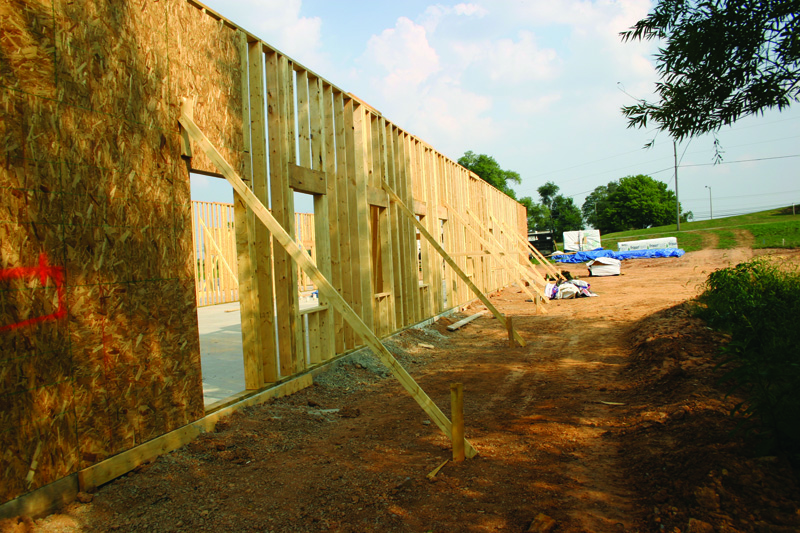 [7]
[7]Design example
The following loadbearing stud wall design example demonstrates standard design checks for limit states of strength and deflection based on methods outlined in AWC’s 2015 NDS, SDPWS, and WFCM Workbook, along with ASCE 7-10. (This article’s example is based on a webinar, “Design of Loadbearing Tall Wood Studs for Wind and Gravity Loads [DES230],” available for free at www.awc.org[8]. Due to space constraints, only highlights of the example are presented here, but full details can be found in the webinar materials.)
The objective is to design a 5.8-m (19-ft) tall loadbearing wall stud in a two-story building with a 6.6-m (25-ft) mean roof height, 9.8-m (32-ft) roof span, and 0.6-m (2-ft) overhangs. Wind loads are 260 km/h (160 mph) and Exposure B. Additionally, the following gravity loads are assumed for the roof:
- dead load = 0.48 kPa (10 psf);
- live load = 0.96 kPa (20 psf); and
- ground snow load = 1.44 kPa (30 psf).
These loads are assumed for the attic and ceiling:
- dead load = 0.72 kPa (15 psf); and
- attic live load = 1.44 kPa (30 psf).
The approach is to analyze wall framing as part of the MWFRS exposed to in-plane and out-of-plane load combinations specified by ASCE 7-10. Studs are then analyzed with out-of-plane C&C wind pressures only. The analysis involves an iterative approach. Initial values are selected for member properties (depth, number of members, species, and grade) and analyses completed. Then, stresses and deflections are determined and compared to allowable values. At this point, the member properties are varied, with analyses repeated until stress and deflection criteria are satisfied.
Southern pine No. 2-grade 2x8s are analyzed assuming 406 mm (16 in.) on-center (o.c.) spacing, wood structural panel exterior sheathing, and 12-mm (½-in.) gypsum wallboard interior sheathing with the following reference design values from the 2015 NDS Supplement Table 4B:
Fb = 6378 kPa (925 psi);
Fc = 9308 kPa (1350 psi);
E = 9,652,660 kPa (1,400,000 psi); and
Emin = 3,516,326 kPa (510,000 psi).
The wall stud bending strength and stiffness design value adjustment factor from SDPWS Table 3.1.1.1 for a 2×8 is equal to 1.25. Load duration factors (CD) apply to the bending and compression design values, but not modulus of elasticity. CD also varies depending on the shortest load duration in the load combination. For load combinations including:
- wind, CD = 1.6;
- roof live loads, CD = 1.25; and
- snow loads, CD = 1.15.
The following Allowable Stress Design (ASD) load combinations per ASCE 7-10 are evaluated for this example:
1. D
2. D + L
3. D + (Lr or S or R)
4. D + 0.75L + 0.75(Lr or S or R)
5. D + (0.6W or 0.7E)
6a. D + 0.75L + 0.75(0.6W) + 0.75(Lr or S or R)
6b. D + 0.75L + 0.75(0.7E) + 0.75S
7. 0.6D + 0.6W
Where:
D = dead load;
L = live load;
Lr = roof live load;
W = wind load (note the 0.6 load factor will be included in the velocity pressure calculations); and
S = snow load.
Both balanced and unbalanced snow loads are analyzed. For this example, an unbalanced snow load of 5.25 N/mm (360 plf) provides the highest snow loads on the studs.
MWFRS wind pressures are calculated using the ‘envelope procedure’ contained in Chapter 28 of ASCE 7-10. The velocity pressure exposure coefficient for a building located in Exposure B with a 7.6-m (25-ft) MRH is 0.70 per ASCE 7-10 Table 28.3-1, and a factor of 0.6 adjusts the pressures associated with a 700-year mean return period wind to allowable stress design. The velocity pressure calculates to 1.12 kPa (23.4 psf).
ASCE 7-10 Figure 28.4-1 shows the external pressure coefficients for interior and end zones for two cases—winds generally perpendicular to the ridge and winds generally parallel to the ridge. Wind perpendicular to the ridge produces the highest external wall pressure coefficients. Reactions at the top of the bearing wall are determined by summing overturning moments about the top of the leeward wall for both load cases and determining the controlling reaction to use in the design. Horizontal projections are used in the analysis. The out-of-plane MWFRS pressure on the wall at interior zones is calculated as 0.83 kPa (17.3 psf).
Load Combinations 1, 2, 3, and 4 model gravity only loads (dead load, live load, and/or snow load). Load Combinations 5, 6a, and 7 include MWFRS loads. Load Combination 6a controls for the load combinations that include wind loads. The bearing walls must resist distributed loads from the attic floor and roof and out-of-plane MWFRS loads proportional to the width of their tributary areas. Using NDS column, beam, and combined bending and axial load provisions, the interaction value calculated per NDS Equation 3.9-3 is 0.46.
ASCE 7-10 provisions for calculating C&C loads are used assuming a minimum effective wind area of L2/3. By observation, negative external pressure coefficients are greater than positive external pressure coefficients. Thus, negative external pressures and positive internal pressures (windward) create the greatest C&C pressures. A C&C pressure of −1.22 kPa (−25.5 psf) is calculated for this example. Applying the C&C pressure as a bending load on the studs calculates a bending stress to bending strength ratio of 0.76—even larger than the combined bending and axial interaction calculated with MWFRS loads.
A deflection check using C&C loads reveals an L/Δ of 273. Assuming either a flexible finish or gypsum-type finish, code deflection limits are typically L/180 and L/240, respectively. While 2x6s could be designed to work for this example from a strength standpoint, the minimum deflection limit for this application of L/180 would be exceeded with 2×6 studs.
Conclusion
Major structural elements should be designed for MWFRS loads, and secondary cladding elements should be designed for C&C loads. Components and assemblies receiving loads both directly and as part of the MWFRS should be checked for MWFRS and C&C loads independently. In cases where components and assemblies must be designed for lateral wind loads, the controlling design case
will often be wind acting alone. However, each load combination should be considered thoroughly before being dismissed.
Now more than ever, designing buildings to withstand potentially devastating high wind forces is one of the greatest challenges construction professionals face. Given wood’s resilient properties in these situations, communities are less likely to sustain damage and should have a faster time getting back up on their feet.
John “Buddy” Showalter, PE, joined the American Wood Council (AWC) in 1992, and serves as vice president of technology transfer. His responsibilities include oversight of publications, website, helpdesk, education and other technical media. Showalter is also a member of the editorial boards for Wood Design Focus (Forest Products Society) and STRUCTURE (National Council of Structural Engineers Associations [NCSEA]/American Society of Civil Engineers/Structural Engineering Institute [ASCE/SEI], and Council of American Structural Engineers [CASE]) magazines. Before joining AWC, Showalter was technical director of the Truss Plate Institute. He can be reached at bshowalter@awc.org[9].
Bradford Douglas, PE, joined AWC in 1986, and serves as vice president of engineering. He directs a program aimed at developing state-of-the-art engineering data, technology, and standards on structural wood products, systems, and assemblies for use by design professionals and building officials. Douglas is on several standards development committees of organizations including ASTM, American Society of Civil Engineers (ASCE), and the U.S. Federal Emergency Management Agency’s Building Seismic Safety Council (BSSC). Since 1987, he has also served on U.S. model building code committees for the Southern Building Code Congress International (SBCCI), the International Council of Building Officials (ICBO), and more recently the International Code Council (ICC) dealing with proper design of wood buildings to resist high wind and seismic loads. He can be reached at (202) 463-2766.
David K. Low, PE, is president of DK Low & Associates, a consulting firm in Charlottesville, Virginia. He has practiced electrical and structural engineering for over 35 years. Since 1998, Low has focused on the effects of natural hazards on the built environment with an emphasis on high wind and flood effects. He is a member of numerous forensic engineering teams that assess building performance after floods, tornadoes, and hurricanes and is a principal or contributing author of several publications for improved building performance and resilience. Low is also a member of code and standard development committees for the National Fire Protection Association (NFPA) and the American Society of Civil Engineers (ASCE). He can be reached at (434) 295-6364.
- [Image]: https://www.constructionspecifier.com/wp-content/uploads/2017/07/IMG_1470-Replacement-Photo.jpg
- [Image]: https://www.constructionspecifier.com/wp-content/uploads/2017/07/IMG_1432.jpg
- [Image]: https://www.constructionspecifier.com/wp-content/uploads/2017/07/IMG_1461.jpg
- awc.org/codes-standards/publications: http://awc.org/codes-standards/publications
- What the 2015 International Building Code means for wood construction: http://www.constructionspecifier.com/what-the-2015-international-building-code-means-for-wood-construction-part-i
- [Image]: https://www.constructionspecifier.com/wp-content/uploads/2017/07/IMG_1445.jpg
- [Image]: https://www.constructionspecifier.com/wp-content/uploads/2017/07/IMG_1437.jpg
- www.awc.org: http://www.awc.org
- bshowalter@awc.org: mailto:bshowalter@awc.org
Source URL: https://www.constructionspecifier.com/wind-and-gravity-design-for-tall-walls-in-wood-buildings/